新目标英语七年级上册Unit5说课稿
新目标英语七年级全英文说课稿unit5

Unit 5 Do you have a soccer ball 说课稿Good morning, ladies and gentlemen:Nice to meet you here. I'd like to say it's a good chance for me to learn from you .Here, my speech contains 4 parts. I would like to introduce them here with your great help.I. The analysis of teaching material:My speech is Section A , Unit 5. Do you have a soccer ball This is an important lesson in Book One. And it is the first lesson of this unit, it talks about recognizing objects(mainly about balls) and the simple question. .The students have already known to answer it"Yes" or "No" in Unit 2 ,but in this unit, it's different. We know, simple question is a kind of important structure. If the students can learn it well, it will be helpful to make the students to learn the special question. And it's related to our daily life closely, so it's very useful.New words: basketball, soccer ball, volleyball, ping-pong ball, ping-pong bat, tennis, tennis racket. Structure: Do you have Does he /she haveTeaching aims:Aims on the knowledge:To study the words about balls by showing the pictures.To make the students know how to ask whether others have something or not, and how to answer it. Aims on the abilities:To develop the students' ability of listening ,speaking, reading and writing.To train the students' ability of communication.Aims on the emotion:⑴.To make the students be interested in good co-operation and competition.⑵To make the students love sports ,love life.Teaching key points and difficult points:How to make the students understand the new language items naturally.How to make the students work well with their partners.How to arouse their interest in learning English.How to make dialogues and act them out.Ⅱ.Teaching methods I will take.1."Communicative" teaching method.2. "Task-based" teaching method.Everyone knows that the main aims of learning English in middle school is to cultivate the students' basic abilities of listening, speaking, reading and writing, and their good sense of the English language.Ⅲ. Learning methods.Firstly, Look, listen, and say to gain language competence.Secondly, Teamwork, exploration and participation to reach the goal.Thirdly, Cultivate skills in listening, speaking, reading and expressing.Fourthly, Students-centered and teacher-guided learning strategies. I'm not a teacher but a guider. I'm ready to give them help whenever they need and re-correct the mistakes while talking.Ⅳ.Teaching procedure design.Step1. Warm-up.Ask the students some easy questions to check if they have remembered the contents they had learned before. For example: What's this Spell it, please. What color is it Is this your pen Is that your backpack and so on.Step2. Presentation.1. Take out a ping-pong ball and ask the students:What's this Why I take out a ping-pong ball here I think it's the easiest and the most popular in our country.2. Leading in new words : here I will play some short plays, they are soccer game,volleyball game, ping-pong competition and an advertisiment, there is a basketball in it.The reason of my design: I think the students can learn the words easily and directly in this way. And I also think it can draw the students' attention and arouse their interest in learning English. With the help of the CAI, it can provide a real situation to understand the meaning of the words, not by presenting the new words one by one and telling them the Chinese meaning. So the students can remember the words quickly and naturally.How to help the students remember the new word, I think I will do it like this: When the word appears under the picture, there may be some students know the word and they will read it out loudly, this time, you may need to correct the pronunciation and teach it, after one or two times, I will ask the students to spell it by themselves. Why I must ask them to spell it themselves, I think it can make them have a general impression of the word. Usually, when you teach them read, most of the students just follow you, they don't look at the word at all. Perhaps, you have taught ten times and they can read it very well following you , but after you teach some more words and ask them to read it again ,they may not be able to.3.Teaching the dialogue:Make a sample dialogue with a student. Show him or her the ping-pong ball and do it like this:T: I have a ping-pong ball. Do you have a ping-pong ball (Here, you may help him answer "Yes, I do." or "No, I don't.")S: Yes, I do.Make the dialogue with some more students,and write it on the blackboard. Make sure they can read and understand the meaning. Next, ask a student if he has a ping-pong ball, then ask the others: "Does he have a ping-pong ball "Here, you must help them answer: "Yes, he does." Or "No, he doesn't." Write it on the blackboard. Teach the dialogue and make sure they can read it and understand the meaning.4. Practice: Read the dialogue by role play. But you must tell them how to do it clearly, make them to ask their partners what kind of balls they have. This time ,they must use the sentence "Do you have a "5. Groupworking and competition: Divide the students into groups of three.Give them an example first :A: Do you have a basketballB: Yes ,I do.A: Does he have a basketballC : Yes, he does.Ask them to make a similar dialogue and tell them that it' s also a competition, after they act it out you will choose a best group at the end.The reason of having a competition: I think it can encourage them to try their best and cooperate with their groupmembers well.6. Listening, listen to the tape and circle the words you hear. It's Activity 1a.Step3. Post-task. Starting a ball club.In this club, there are four teams: a basketball team, a soccer ball team, a ping-pong ball team and a tennis team. I will ask four students to be the captain of each team. They should ask their classmates to be their team members. If he has a basketball,he should join the basketball team.The reason I give this task: I think this activity is the consolidation of this lesson. It is helpful to revise and consolidate the contents we learned in this lesson.Blackboard design:Ping-pong ball /bat Do you have a ping-pong ballSoccer ball Yes, I do./No, I don't.BasketballV olleyball Does he have a soccer ballTennis racket Yes, he does.Does she have a volleyballNo, she doesn't.That's my speaking. Thanks for your listening.。
七年级英语上册(人教版)Unit5单元整体说课稿

一、教材分析
(一)内容概述
人教版七年级英语上册Unit 5主要围绕“My family and friends”展开,通过介绍家庭成员和朋友,让学生学习并掌握与家庭成员和朋友相关的词汇和表达方式,同时学习一般现在时态。此单元在整个课程体系中处于第二单元,紧接第一单元的“Hello, my name is...”,进一步加深学生对英语日常交流的理解和运用。主要知识点包括家庭成员和朋友的相关词汇,如mother, father, sister, brother, friend等;一般现在时态的构成和用法,如I like watching movies, She is a teacher等。
3.情感态度与价值观:培养学生对家庭成员和朋友的关爱和尊重,增强学生的人际交往能力,提高学生对英语学习的兴趣和积极性。
(三)教学重难点
1.教学重点:本节课的教学重点是一般现在时态的构成和用法,以及家庭成员和朋友的相关词汇。学生需要掌握一般现在时态的肯定句、否定句和疑问句的构成,并能运用所学词汇和句型进行实际交流。
(三)巩固练习
为了帮助学生巩固所学知识并提升应用能力,我计划设计以下巩固练习和实践活动:
1.小组讨论:学生分组讨论自己的家庭成员和朋友,用英语进行介绍和描述,并练习运用一般现在时态。
2.角色扮演:学生分组进行角色扮演,模拟真实场景,用英语介绍家庭成员和朋友,并尝试运用一般现在时态。
3.练习题:设计一些练习题,让学生在纸上完成,检测他们对家庭成员和朋友词汇和一般现在时态的掌握情况。
为了激发学生的学习兴趣和动机,我将采取以下策略或活动:
1.通过图片、视频等直观教具展示家庭成员和朋友的情景,引发学生的好奇心和兴趣。
Unit-5-Why-do-you-like-pandas说课稿
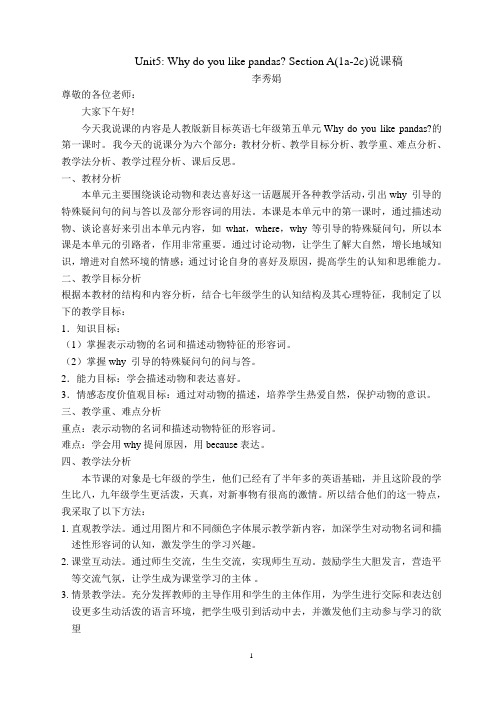
Unit5: Why do you like pandas? Section A(1a-2c)说课稿李秀娟尊敬的各位老师:大家下午好!今天我说课的内容是人教版新目标英语七年级第五单元Why do you like pandas?的第一课时。
我今天的说课分为六个部分:教材分析、教学目标分析、教学重、难点分析、教学法分析、教学过程分析、课后反思。
一、教材分析本单元主要围绕谈论动物和表达喜好这一话题展开各种教学活动,引出why 引导的特殊疑问句的问与答以及部分形容词的用法。
本课是本单元中的第一课时,通过描述动物、谈论喜好来引出本单元内容,如what,where,why等引导的特殊疑问句,所以本课是本单元的引路者,作用非常重要。
通过讨论动物,让学生了解大自然,增长地域知识,增进对自然环境的情感;通过讨论自身的喜好及原因,提高学生的认知和思维能力。
二、教学目标分析根据本教材的结构和内容分析,结合七年级学生的认知结构及其心理特征,我制定了以下的教学目标:1.知识目标:(1)掌握表示动物的名词和描述动物特征的形容词。
(2)掌握why 引导的特殊疑问句的问与答。
2.能力目标:学会描述动物和表达喜好。
3.情感态度价值观目标:通过对动物的描述,培养学生热爱自然,保护动物的意识。
三、教学重、难点分析重点:表示动物的名词和描述动物特征的形容词。
难点:学会用why提问原因,用because表达。
四、教学法分析本节课的对象是七年级的学生,他们已经有了半年多的英语基础,并且这阶段的学生比八,九年级学生更活泼,天真,对新事物有很高的激情。
所以结合他们的这一特点,我采取了以下方法:1. 直观教学法。
通过用图片和不同颜色字体展示教学新内容,加深学生对动物名词和描述性形容词的认知,激发学生的学习兴趣。
2. 课堂互动法。
通过师生交流,生生交流,实现师生互动。
鼓励学生大胆发言,营造平等交流气氛,让学生成为课堂学习的主体。
3. 情景教学法。
牛津译林版七年级上册Unit5《Let’scelebrate》(第2课时)说课稿
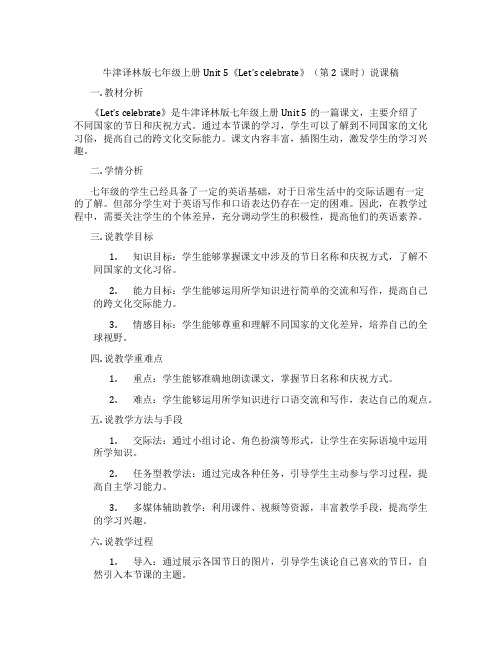
牛津译林版七年级上册Unit 5《Let’s celebrate》(第2课时)说课稿一. 教材分析《Let’s celebrate》是牛津译林版七年级上册Unit 5的一篇课文,主要介绍了不同国家的节日和庆祝方式。
通过本节课的学习,学生可以了解到不同国家的文化习俗,提高自己的跨文化交际能力。
课文内容丰富,插图生动,激发学生的学习兴趣。
二. 学情分析七年级的学生已经具备了一定的英语基础,对于日常生活中的交际话题有一定的了解。
但部分学生对于英语写作和口语表达仍存在一定的困难。
因此,在教学过程中,需要关注学生的个体差异,充分调动学生的积极性,提高他们的英语素养。
三. 说教学目标1.知识目标:学生能够掌握课文中涉及的节日名称和庆祝方式,了解不同国家的文化习俗。
2.能力目标:学生能够运用所学知识进行简单的交流和写作,提高自己的跨文化交际能力。
3.情感目标:学生能够尊重和理解不同国家的文化差异,培养自己的全球视野。
四. 说教学重难点1.重点:学生能够准确地朗读课文,掌握节日名称和庆祝方式。
2.难点:学生能够运用所学知识进行口语交流和写作,表达自己的观点。
五. 说教学方法与手段1.交际法:通过小组讨论、角色扮演等形式,让学生在实际语境中运用所学知识。
2.任务型教学法:通过完成各种任务,引导学生主动参与学习过程,提高自主学习能力。
3.多媒体辅助教学:利用课件、视频等资源,丰富教学手段,提高学生的学习兴趣。
六. 说教学过程1.导入:通过展示各国节日的图片,引导学生谈论自己喜欢的节日,自然引入本节课的主题。
2.新课展示:教师带领学生朗读课文,讲解生词和短语,让学生了解不同国家的节日和庆祝方式。
3.课堂活动:学生分组讨论,分享自己了解的节日习俗,进行角色扮演,模拟交际场景。
4.写作练习:学生根据所学内容,写一篇关于自己喜欢的节日的短文。
5.总结与拓展:教师引导学生总结本节课所学内容,鼓励学生课后深入了解其他国家的节日文化。
人教版英语七年级上册Unit5SectionA1a1c说课稿

在教学过程中,我预见到以下可能的问题或挑战:
1.部分学生对一般现在时态的掌握不够熟练,容易混淆;
2.学生在口语练习时可能出现紧张、胆怯等情况;
3.课堂时间分配不合理,可能导致教学进度受到影响。
应对策略:
1.针对时态混淆问题,通过对比、举例等方式,帮助学生明确区别;
2.鼓励学生大胆开口,创设轻松的口语练习氛围;
(二)媒体资源
我将使用以下教具、多媒体资源和技术工具来辅助教学:
1.教具:实物、图片、卡片等,用于直观展示家庭成员和物品,激发学生的兴趣和注意力。
2.多媒体资源:PPT、视频、音频等,通过展示生动有趣的场景和对话,提高学生的听说能力,增强课堂氛围。
3.技术工具:电子白板、教学互动平台等,实现课堂实时互动,方便学生参与讨论、展示和反馈。
3.教师反馈:针对学生的表现,给予积极的评价和鼓励,同时指出需要改进的地方,并提供具体的建议。
(五)作业布置
课后作业布置如下:
1.复习本节课所学的家庭成员词汇和句型,确保掌握。
2.完成课后练习题,巩固所学知识。
3.家长协助孩子用英语介绍自己的家庭成员,录制视频,上传至教学互动平台,以便教师了解学生的实际应用情况。
2.口语练习:组织学生进行角色扮演,模拟真实场景进行对话练习,提高口语表达能力。
3.课后作业:设计一些练习题,如填空、选择、句型转换等,让学生在课后巩固所学知识。
(四)总结反馈
在总结反馈阶段,我将采取以下措施:
1.引导学生自我评价:让学生回顾本节课所学内容,反思自己的学习过程,总结收获和不足。
2.同伴评价:组织学生相互评价,提出改进建议,促进共同进步。
1.教学重点:
(1)家庭成员词汇的掌握;
新目标英语初一上第五单元说课稿

学生能真正的做到用语言进行交际的最终目的。
说教材 教材分析
本单元是新目标英语七年级上第5单元,教材内容围绕着询问Do you have…?展开,让学生学会谈论实物。本单元词汇重点与学生的实际生活密切相关,易于引发学生运用简单的英语进行交际和交流。在学习活动中运用句型进行交际,学习英语最基本句型——实意动词的一般现在时,并让学生将知识应用到实践中,做到学以致用。 这一单元在正本教材重点作用可谓是至关重要。既是第三单元be的一般现在时的深入学习,又是初中英语时态学习的根基和重中之重。
英语说课稿 新目标英语 Go for it ! Unit 5 Do you have a soccer ball?
说课者:周仁华
汇报日期
单击此处添加副标题
说课的内容 :
说学情 说教材 说教法 说教学程序
一、说学情
我所设计的课程针对的学生有如下特点:
学习习惯差 没有养成良好的预习和复习习惯。
基础差 这些学生都是暑期六升七新招学生,大部分都未经过辅导班的知识训练。
四.说教学程序
3.以he为例,引导学生合作讨论“主语是三单, V怎么变?” He has a soccer ball . He doesn’t have a soccer ball . 4.引出以下重点: 助动词do/does及don’t/doesn’t用法 依次写出Does he have a soccer ball ? Yes , he does . No ,he doesn’t . 5.总结S非三单和S三单的一般现在时
四.说教学程序
四.说教学程序
Step3.Learning_单词 单词的拼读 单词的语言点 Step4. Learning_课文 整个课文知识点的罗列 重点段落的知识点的归纳 Step5.Exercise(Homework)
人教版新课标英语七年级上册《Unit5SectionAGrammarfocus3a-3c》说课稿3

人教版新课标英语七年级上册《Unit 5 Section A Grammar focus 3a-3c》说课稿3一. 教材分析人教版新课标英语七年级上册《Unit 5 Section A Grammar focus 3a-3c》是一篇关于一般现在时的语法教学内容。
通过本节课的学习,学生能够掌握一般现在时的构成、用法以及主语和谓语动词的一致性。
教材中通过情境交际的方式,让学生在实际语境中感知、理解和运用一般现在时,从而提高他们的语言运用能力。
二. 学情分析七年级的学生已经具备了一定的英语基础,对英语学习有了一定的认识。
但他们在语言运用方面还存在一定的困难,特别是在时态和语态的运用上。
因此,在教学过程中,教师需要关注学生的个体差异,因材施教,引导学生逐步掌握一般现在时的用法。
三. 说教学目标1.知识目标:学生能够掌握一般现在时的构成、用法以及主语和谓语动词的一致性。
2.能力目标:学生能够在实际语境中感知、理解和运用一般现在时,提高他们的语言运用能力。
3.情感目标:激发学生学习英语的兴趣,培养他们积极向上的学习态度。
四. 说教学重难点1.教学重点:一般现在时的构成、用法以及主语和谓语动词的一致性。
2.教学难点:一般现在时的实际运用,特别是在语境中的运用。
五. 说教学方法与手段1.教学方法:采用情境教学法、交际法、任务型教学法等,让学生在实际语境中学习、运用一般现在时。
2.教学手段:利用多媒体课件、图片、卡片等辅助教学,提高学生的学习兴趣和参与度。
六. 说教学过程1.导入:通过与学生生活相关的话题,引出一般现在时的概念,激发学生的学习兴趣。
2.呈现:展示一般现在时的情境交际,让学生感知一般现在时的用法。
3.操练:通过小组活动、游戏等形式,让学生在实际语境中练习一般现在时的运用。
4.巩固:通过完成任务、角色扮演等活动,让学生进一步巩固一般现在时的用法。
5.拓展:引导学生运用一般现在时进行创新性表达,提高他们的语言运用能力。
新目标英语七年级上册unit5教学设计
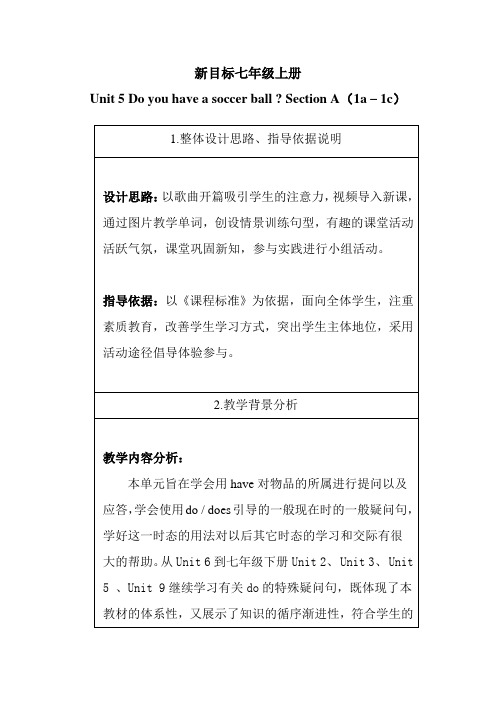
竞赛能调
的图片.
动学生学
习的积极
2.给猜对方颁发 2. 展 开 男 女 生 竞 性,初步
一颗红星。
赛。
掌握与球
类相关的
词汇,调
动课堂气
氛。
使用
多种方法
game.
Step 6 Go through 1a.
1. Show the 1. A volunteer 练单词,
pictures of the guesses the word 减少了枯
have a soccer do. 没有用到此单 面向全体
ball?
词的学生集体起立 学生的课
3. 将此句型书写
回答:No. I don’t.
改精神。
在黑板上。 ② 4. 通过课件 展示表格,再次
②再
4. PK. 猜测 Yes 次练习一
or no. 猜对者会得 般 疑 问
到一颗星,然后展 句,练习
开对话。
balls one by one. according to the 燥,降低
others’ motion.
了难度。
表演的方
式,充分
发挥了学
生们的想
象力。
1. Tell the Ss : 1. Finish by 通过以上
Match the words themselves.
环节的巩
with the things
into
two
于调动学
groups: boys
生参与课
and girls.
堂活动的
热情。
Step 3 Enjoy a video.
Step 3 New words .
Step 4 Guess.
七年级英语unit5说课稿
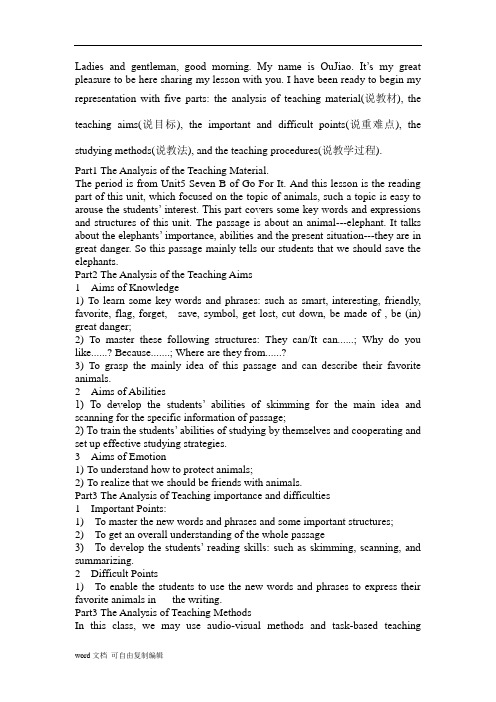
Ladies and gentleman, good morning. My name is OuJiao. It’s my great pleasure to be here sharing my lesson with you. I have been ready to begin my representation with five parts: the analysis of teaching material(说教材), theteaching aims(说目标), the important and difficult points(说重难点), thestudying methods(说教法), and the teaching procedures(说教学过程).Part1 The Analysis of the Teaching Material.The period is from Unit5 Seven B of Go For It. And this lesson is the reading part of this unit, which focused on the topic of animals, such a topic is easy to arouse the students’ interest. This part covers some key words and expressions and structures of this unit. The passage is about an animal---elephant. It talks about the elephants’ importance, abilities and the pre sent situation---they are in great danger. So this passage mainly tells our students that we should save the elephants.Part2 The Analysis of the Teaching Aims1 Aims of Knowledge1) To learn some key words and phrases: such as smart, interesting, friendly, favorite, flag, forget, save, symbol, get lost, cut down, be made of , be (in) great danger;2) To master these following structures: They can/It can......; Why do you like......? Because.......; Where are they from......?3) To grasp the mainly idea of this passage and can describe their favorite animals.2 Aims of Abilities1) To develop the students’ abilities of skimming for the main idea and scanning for the specific information of passage;2) To train the students’ abilities of studying by th emselves and cooperating and set up effective studying strategies.3 Aims of Emotion1)To understand how to protect animals;2)To realize that we should be friends with animals.Part3 The Analysis of Teaching importance and difficulties1 Important Points:1) To master the new words and phrases and some important structures;2) To get an overall understanding of the whole passage3) To develop the students’ reading skills: such as skimming, scanning, and summarizing.2 Difficult Points1) To enable the students to use the new words and phrases to express their favorite animals in the writing.Part3 The Analysis of Teaching MethodsIn this class, we may use audio-visual methods and task-based teachingmethods. Besides, powerpoint, a tape recorder, blackboard, a projector are needed as the teaching aids.Part4 The analysis of Teaching ProcedureStep1 Lead inI’ll raise three questions related to the reading material:1) What’s your favorite animal? Panda, elephant...2) Why do you like them? Because they are...3) Where are they from? China/ Thailand.Next, I’ll show some pictures with elephants that are in danger, and ask the students what’s wrong with these animals?Purpose: On the one hand, we can guide students to review what we have learned in the last class through three questions; on the other hand, we can introduce some information about this passage to enlarge the students’ background by showing the pictures. So the students can have a better understanding of this passage in the following studying.Step2 Fast reading and Finish the chart in 2c.At first, I will divide the whole class into four groups, and ask each group to finish one part in 2c at their first listening about the text. Then, I will give them some minutes to discuss the answers and complete the mind map. Finally, I will choose one student of each group to answer the questions and check their answers together.Purpose: This step is aim to develop students’ reading ability of scanning for the specific information and to develop the spirit of cooperation through teamwork.Step3 Intensive readingListen again, according to the mind map, I will guide the students to summarize Importance in Thailand ● first flag had● symbol ofFacts and figures ● People many trees ● People kill them for ● Today there are (over before) Abilities ● Can play ● Can also ● Can places with food andwaterHow to save them ● Don ’t cut down so many ● Don ’t things made of ivory ● is Thai Elephant Day ELEPHABT Sthe main idea of each paragraph, and explain the important words and phrases in each paragraph. Finally, I will ask them to finish the task in 2b---to choose the best title of this passage.Purpose: through intensive reading, it’s helpful to learn the new words and phrases which they come across while reading. And it’s good for them to have a better understanding of this passage through summarizing the main idea of each paragraph.Step4 Retell the whole passage.According to the mentions on the blackboard, I will guide students to retell the whole passage, and ask them to describe their favorite animals in oral centering on this five questions..1 What’s your favorite animals?2 Why do you like them?3 What can they do?4 Where are they from?5 How can we protect them?Purpose: to improve the students’ ability of expressing in oral. At the sam e time, it can evaluates how well the students learned in this class.Step5 Homework1 to read and recite paragraph 2-3;2 to write a short passage to describe their favorite animal.Part5 Evaluation and Reflection1 to review the contents of the whole lesson;2 to raise the awareness of protecting animals.。
人教版新目标七年级英语上册Unit 5集体备课教案设计
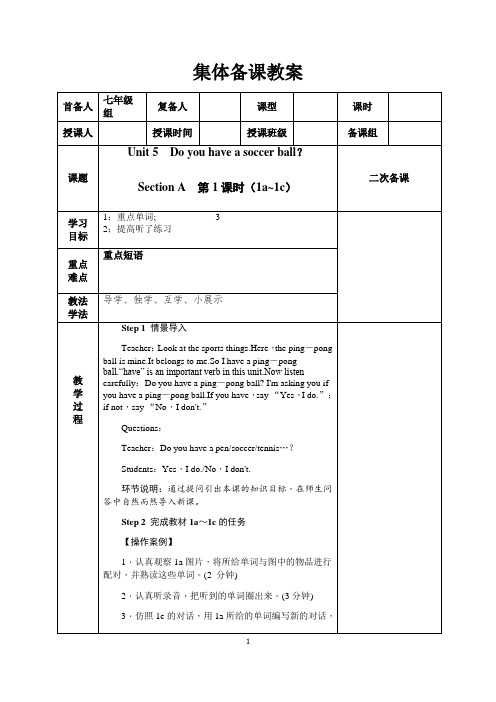
Teacher:Do you have a pen/soccer/tennis…?
Students:Yes,I do./No,I don't.
环节说明:通过提问引出本课的知识目标,在师生问答中自然而然导入新课。
Step 2完成教材1a~1c的任务
【操作案例】
1.认真观察1a图片,将所给单词与图中的物品进行配对,并熟读这些单词。(2分钟)
I think he has a ping-pong ball,too.
我认为他也有一个乒乓球。
That sounds good.那听起来不错。
教法
学法
导学、独学、互学、小展示
教
学
过
程
教
学
过
程
Step 1情景导入
Teacher:Do you have a volleyball?
Student 1:Yes,I do.
Teacher:Nice.Let’s play volleyball.
Teacher:Do you have a basketball?
Student 2:No,I don’t.
Teacher:Oh,what a pity! You don’t have a basketball.Well,let’s play soccer.
Teacher:Do you have a basketball?
Student 1:Yes,I do.
Teacher:Does he(Student 1) have a basketball?
Student 2:Yes,he does.
Teacher:Do you have a volleyball?
人教版英语七年级上册Unit5Doyouhaveasoccerball说课稿

人教版英语七年级上册Unit 5 Do you have a soccer ball说课稿一. 教材分析人教版英语七年级上册Unit 5 Do you have a soccer ball是一篇以询问和描述物品为主题的课文。
本节课的主要内容是让学生掌握一般现在时态的疑问句和回答,以及学会使用have作为实义动词的用法。
通过对课文的学习,学生能够提高自己的听说能力和交际能力。
二. 学情分析针对七年级的学生,他们对英语已经有了一定的了解和掌握,但仍有部分学生对英语学习存在恐惧心理,学习积极性不高。
针对这一情况,教师需要在教学过程中注重激发学生的学习兴趣,提高他们的学习积极性。
此外,学生在本节课需要掌握一般现在时态的疑问句和回答,以及实义动词have的用法,这对他们来说是一个新的知识点,需要在教学中进行重点讲解和练习。
三. 说教学目标1.知识目标:学生能够掌握一般现在时态的疑问句和回答,以及实义动词have的用法。
2.能力目标:学生能够听懂、会说本节课的主要句型,提高自己的听说能力。
3.情感目标:通过本节课的学习,学生能够激发对英语学习的兴趣,提高自己的学习积极性。
四. 说教学重难点1.重点:一般现在时态的疑问句和回答,实义动词have的用法。
2.难点:一般现在时态的疑问句和回答的运用,实义动词have在不同语境中的用法。
五. 说教学方法与手段1.采用情境教学法,通过设定生活情境,让学生在实际语境中学习英语。
2.运用任务型教学法,让学生在完成任务的过程中,巩固所学知识。
3.采用分组合作学习,提高学生的团队协作能力和交际能力。
4.利用多媒体教学手段,如PPT、视频等,丰富教学内容,提高学生的学习兴趣。
六. 说教学过程1.导入:通过问答方式,引导学生复习一般现在时态的肯定句和否定句。
2.新课呈现:展示课文图片,引导学生回答问题,引入本节课的主题。
3.课堂讲解:讲解一般现在时态的疑问句和回答,以及实义动词have的用法。
人教版七年级英语上册Unit5SectionA1a1c说课稿

为了帮助学生巩固所学知识并提升应用能力,我计划设计以下巩固练习和实践活动:
1.小组讨论:让学生分组,讨论他们自己的宠物或喜欢的事物,用一般现在时态和情态动词can进行描述。
2.角色扮演:让学生分组,扮演故事中的角色,进行对话练习,运用一般疑问句进行互动。
3.听力练习:播放一段对话,要求学生听懂并回答相关问题,检验他们对一般现在时态、情态动词can和一般疑问句的理解和运用。
(二)媒体资源
为了辅助教学,我将使用图片、视频、电子白板等多媒体资源。图片和视频能够生动展示故事情节,吸引学生的注意力;电子白板则可以用于展示语法点和词汇,方便学生理解和记忆。此外,我还将利用教学软件进行听力练习和口语练习,提高学生的听说能力。这些媒体资源在教学中的作用在于提供丰富的学习材料,创设真实的语言环境,激发学生的学习兴趣,帮助他们更好地理解和掌握英语知识。
(三)互动方式
在师生互动环节,我计划采用问题引导、讨论和反馈等方式。通过提问,引导学生思考和回答问题,激发他们的学习兴趣和思维能力。在生生互动环节,我将以小组合作的形式设计任务,让学生在小组内进行交流、讨论和分享。此外,我还计划组织角色扮演活动,让学生在实际语境中运用所学知识,提高他们的语言实践能力。这些互动方式能够促进学生的参与和合作,使他们能够在交流中发现问题、解决问题,共同提高英语水平。
3.采用小组合作学习方式,鼓励学生互相交流、讨论,培养他们的合作意识和团队精神。
4.适时给予表扬和鼓励,让学生感ቤተ መጻሕፍቲ ባይዱ到学习的成就感和进步,增强自信心。
5.通过设置不同难度的任务,满足不同学生的学习需求,让每个学生都能在课堂上找到适合自己的学习节奏。
三、教学方法与手段
(一)教学策略
在本节课的教学中,我将采用情境教学法、交际教学法和任务型教学法。情境教学法通过设定真实的生活情境,让学生在实际语境中学习和运用英语,提高他们的语言实践能力。交际教学法注重培养学生之间的交际互动,使他们能够在交流中学会表达、倾听和理解。任务型教学法则通过完成具体任务,让学生在实践中运用所学知识,培养他们的自主学习能力和团队协作精神。这些教学方法的理论依据在于现代英语教学理念,即以学生为中心,注重培养学生的语言运用能力和综合素质。
新目标英语七年级上册Unit5说课稿
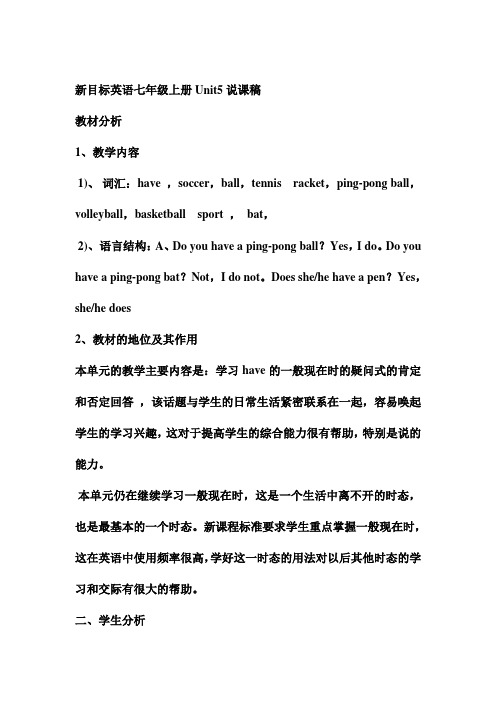
新目标英语七年级上册Unit5说课稿教材分析1、教学内容1)、词汇:have ,soccer,ball,tennis racket,ping-pong ball,volleyball,basketball sport ,bat,2)、语言结构:A、Do you have a ping-pong ball?Yes,I do。
Do you have a ping-pong bat?Not,I do not。
Does she/he have a pen?Yes,she/he does2、教材的地位及其作用本单元的教学主要内容是:学习have的一般现在时的疑问式的肯定和否定回答,该话题与学生的日常生活紧密联系在一起,容易唤起学生的学习兴趣,这对于提高学生的综合能力很有帮助,特别是说的能力。
本单元仍在继续学习一般现在时,这是一个生活中离不开的时态,也是最基本的一个时态。
新课程标准要求学生重点掌握一般现在时,这在英语中使用频率很高,学好这一时态的用法对以后其他时态的学习和交际有很大的帮助。
二、学生分析学生现有的能力与已掌握的知识:学生在已经学过词汇:What is this ?What is that?句型: Where is…? It’s in / on / under/…经过前面的学习学生已经积累了一定的词汇,掌握了一定的目标语,已经具备了一定的听说读写能力。
三、教学目标1、语言知识词汇:A、重点掌握表示有关各种运动球类的名词, 如basketball, soccerball,so on重点句型:? Do you/they have a TV? Yes,I/they do./No,I/they don’t.Does he/she have a soccer ball? Yes,he/she does./No,he/she doesn’t.2、语言技能1)、能看着图片说;Do you/they have a TV? Yes,I/they do./No,I/they don’t.Does he/she have a soccer ball? Yes,he/she does./No,he/she doesn’t.3、学习策略1)、利用老师所提供的图片卡片做出简单的判断。
新目标英语七上Unit-5-Section-B说课稿

新目标英语七上U n i t-5-S e c t i o n-B说课稿(总2页) -本页仅作为预览文档封面,使用时请删除本页-Unit 5 Do you have a soccer ball Section B 说课稿一、说教材这堂课是新目标英语七年级上册的第五单元Do you have a soccer ball的section B(1a-1d)内容.由于新目标英语是采用的任务型教学模式,以话题为主线,兼顾了一个交际功能和基础知识的落实。
根据教材这一特点,本节课就是围绕着“谈论体育运动”这一话题展开,围绕“Let’s play…… That sounds interesting.”两个句子开展了听说教学活动,目的是通过这一节课的学习,让学生学会谈论自己喜爱的体育运动并说出理由。
二、说学情通过前面听过这个班的几节课,了解到本级学生在小学英语学得不错,口语能力较为突出,课堂积极回答问题的气氛浓厚。
因此在教学中插入了大量的课外说与写的提高训练。
争取做到本节内容当堂巩固。
三、说教学目标一)知识与能力目标1、学会形容词interesting,boring,fun,difficult,relaxing等,并会恰当地使用这些描述性形容词。
2、继续学习并掌握目标语言:Do you have a /an ……Yes,I do./No, I don’t.Does he /she have a /an ……Yes,he/she does. /No, he/she doesn’t.I /You/They have……. He/ She has ……Let’s play volleyball. That sounds interesting.二)过程与方法目标运用对子合作的学习策略,引导学生进行听力和口语交际训练。
学会使用do和does 引导的一般疑问句,学会用Let’s…提建议,并能够谈论自己喜欢哪些球类运动,不喜欢哪些球类运动及其原因,能够谈论怎样和自己的朋友度过一段愉快的时光。
新目标英语七年级上Unit 5教学设计
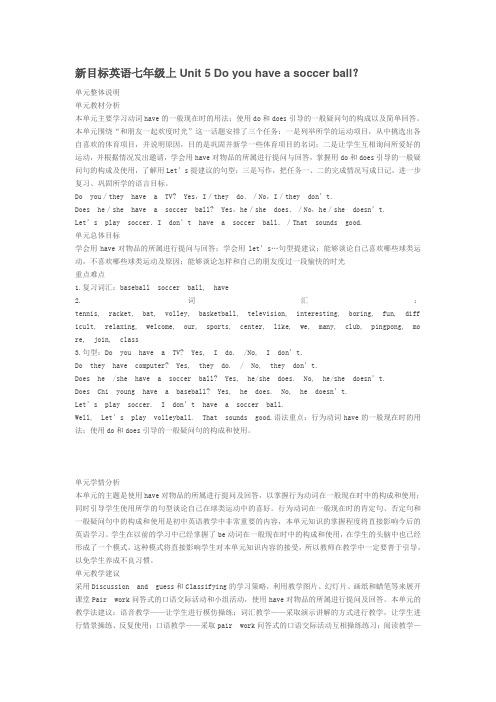
新目标英语七年级上Unit 5 Do you have a soccer ball?单元整体说明单元教材分析本单元主要学习动词have的一般现在时的用法;使用do和does引导的一般疑问句的构成以及简单回答。
本单元围绕“和朋友一起欢度时光”这一话题安排了三个任务:一是列举所学的运动项目,从中挑选出各自喜欢的体育项目,并说明原因,目的是巩固并新学一些体育项目的名词;二是让学生互相询问所爱好的运动,并根据情况发出邀请,学会用have对物品的所属进行提问与回答,掌握用do和does引导的一般疑问句的构成及使用,了解用Let’s提建议的句型;三是写作,把任务一、二的完成情况写成日记,进一步复习、巩固所学的语言目标。
Do you/they have a TV? Yes,I/they do./No,I/they don’t.Does he/she have a soccer ball? Yes,he/she does./No,he/she doesn’t.Let’s play soccer.I don’t have a soccer ball./That sounds good.单元总体目标学会用have对物品的所属进行提问与回答;学会用let’s…句型提建议;能够谈论自己喜欢哪些球类运动,不喜欢哪些球类运动及原因;能够谈论怎样和自己的朋友度过一段愉快的时光重点难点1.复习词汇:baseball soccer ball, have2.词汇:tennis, racket, bat, volley, basketball, television, interesting, boring, fun, diff icult, relaxing, welcome, our, sports, center, like, we, many, club, pingpong, mo re, join, class3.句型:Do you have a TV? Yes, I do. /No, I don’t.Do they have computer? Yes, they do. / No, they don’t.Does he /she have a soccer ball? Yes, he/she does. No, he/she doesn’t.Does Chi young have a baseball? Yes, he does. No, he doesn’t.Let’s play soccer. I don’t have a soccer ball.Well, Let’s play volleyball. That sounds good.语法重点:行为动词have的一般现在时的用法;使用do和does引导的一般疑问句的构成和使用。
人教版初中英语七年级上Unit+5说课稿

Unit 5 Do you have a soccer ball?第一课时说课稿一、教材分析本节课是Go for it!七年级上册Unit 5第一课时的内容。
它以Do you have a soccer ball?为题介绍了日常生活中常见的一些体育用品名称。
如:have, soccer ball ,ping-pong ball ,baseball , basketball ,tennis ,ping-pong bat ,tennis racket等,围绕球类名称,通过I have a/an… I don’t have a/an…A: Do you have a /an…?B: Yes,I do./ No,I don’t. 和拓展句型A: Do they /…have a /an…?B: Yes,they do./ No,they don’t.句型的操练,学习动词have的一般现在时用法。
在已学习Is this your pencil?确认物品所属的基础上,进一步对物品的所属进行问答,培养学生运用知识的能力,通过这些英语交流以促进学生努力提高自己的听、说、读、写的能力。
二、教学目标1. 知识目标(1)词汇:have, soccer ball ,ping-pong ball ,basketball baseball ,tennis ,ping-pong bat ,tennis racket.(2)句型:I have a/an… I don’t have a/an…A: Do you have a /an…?B: Yes,I do./ No,I don’t.A: Do they/… have a /an…?B: Yes,they do./ No,they don’t.2. 能力目标:(1)掌握所给的有关体育词汇,运用所属关系句型:Do you have a soccer ball?进行问答,并能把它们运用到生活中去。
教学设计 七年级上unit5Section说课稿
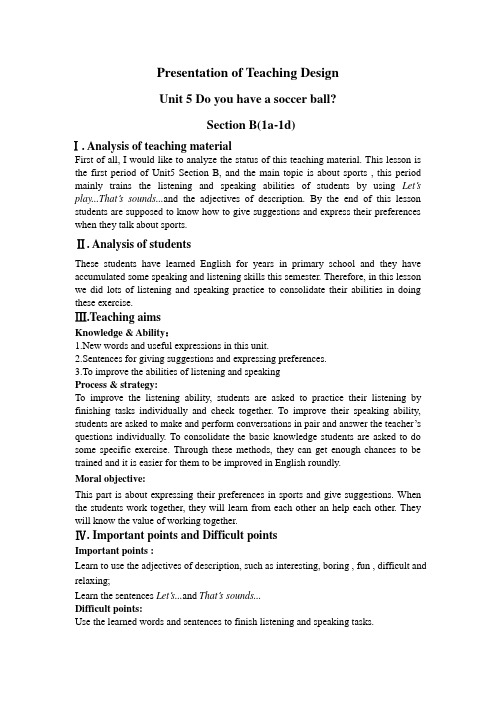
Presentation of Teaching DesignUnit 5 Do you have a soccer ball?Section B(1a-1d)Ⅰ. Analysis of teaching materialFirst of all, I would like to analyze the status of this teaching material. This lesson is the first period of Unit5 Section B, and the main topic is about sports , this period mainly trains the listening and speaking abilities of students by using Let’s play...That’s sounds...and the adjectives of description. By the end of this lesson students are supposed to know how to give suggestions and express their preferences when they talk about sports.Ⅱ. Analysis of studentsThese students have learned English for years in primary school and they have accumulated some speaking and listening skills this semester. Therefore, in this lesson we did lots of listening and speaking practice to consolidate their abilities in doing these exercise.Ⅲ.Teaching aimsKnowledge & Ability:1.New words and useful expressions in this unit.2.Sentences for giving suggestions and expressing preferences.3.To improve the abilities of listening and speakingProcess & strategy:To improve the listening ability, students are asked to practice their listening by finishing tasks individually and check together. To improve their speaking ability, students are asked to make and perform conversations in pair and answer the teacher’s questions individually. To consolidate the basic knowledge students are asked to do some specific exercise. Through these methods, they can get enough chances to be trained and it is easier for them to be improved in English roundly.Moral objective:This part is about expressing their preferences in sports and give suggestions. When the students work together, they will learn from each other an help each other. They will know the value of working together.Ⅳ. Important points and Difficult pointsImportant points :Learn to use the adjectives of description, such as interesting, boring , fun , difficult and relaxing;Learn the sentences Let’s...and That’s sounds...Difficult points:Use the learned words and sentences to finish listening and speaking tasks.Ⅴ.Teaching ProceduresStep 1 : learning aimsStep2: lead inReview the sentences in Grammar Focus and begin the new words learning by using the connected topic.Step3: presentation 2.Match the words with the pictures (1a ), then check the answers and read the words twice. Try to let students be familiar to the new words as much as possible . Step4: listening practice (1b and 1c)1.First read the instructions to the students in both1b and 1c, make sure they understand the meaning, then play the recorder, let students finish their exercise.2.Check together by play the recorder again and ask students to repeat.3. Show the listening material on the screen and ask students to pay attention to the colorful sentences.Step5: speaking practice1.Show the pictures, lead students to make sentences.2.Then give students some time and ask some pairs to act out their conversations about sports.3.Then ask some pairs to act out their conversations about sports.Step6: consolidationAsk students to fill in the blanks to finish the conversation, then ask them to act the conversation.Step7:homework1. Remember the adjectives of description2. Review the words of sports3. Preview the reading passage in 2aⅥ. Blackboard and MultimediaIt is better to use both blackboard and multimedia. So I designed the board like this : Unit5 Do you have a soccer ball?Words:interesting, difficult, boring, fun, relaxing, watch TVSentences:Let ’s play basketball. That ’s sounds interesting.Ⅶ.ConclusionAll above is my teaching plan. I reviewed the knowledge in last period and lead in the new lesson with pictures. Students not only learned the basic adjectives of description but improved their abilities in listening and speaking after lots of exercise during this period. They also practiced their expressing of preferences and how to give suggestions. Through all this lesson, students are always the host and I played a role of helper. Because I know clearly that learning is something about themselves, and practice makes perfect.。
- 1、下载文档前请自行甄别文档内容的完整性,平台不提供额外的编辑、内容补充、找答案等附加服务。
- 2、"仅部分预览"的文档,不可在线预览部分如存在完整性等问题,可反馈申请退款(可完整预览的文档不适用该条件!)。
- 3、如文档侵犯您的权益,请联系客服反馈,我们会尽快为您处理(人工客服工作时间:9:00-18:30)。
新目标英语七年级上册Unit5说课稿青铜峡第五中学王俊霞教材分析1、教学内容1)、词汇:have ,soccer,ball,tennis racket,ping-pong ball,volleyball,basketball sport , bat,2)、语言结构:A、Do you have a ping-pong ball?Yes,I do。
Do you have a ping-pong bat?Not,I do not。
Does she/he havea pen?Yes,she/he does2、教材的地位及其作用本单元的教学主要内容是:学习have的一般现在时的疑问式的肯定和否定回答,该话题与学生的日常生活紧密联系在一起,容易唤起学生的学习兴趣,这对于提高学生的综合能力很有帮助,特别是说的能力。
本单元仍在继续学习一般现在时,这是一个生活中离不开的时态,也是最基本的一个时态。
新课程标准要求学生重点掌握一般现在时,这在英语中使用频率很高,学好这一时态的用法对以后其他时态的学习和交际有很大的帮助。
二、学生分析学生现有的能力与已掌握的知识:学生在已经学过词汇:What is this ? What is that?句型:Where is…? It’s in / on / under/…经过前面的学习学生已经积累了一定的词汇,掌握了一定的目标语,已经具备了一定的听说读写能力。
三、教学目标1、语言知识词汇:A、重点掌握表示有关各种运动球类的名词, 如basketball, soccerball,so on重点句型:? Do you/they have a TV? Yes,I/they do./No,I/they don’t.Does he/she have a soccer ball? Yes,he/she does./No,he/she doesn’t.2、语言技能1)、能看着图片说;Do you/they have a TV? Yes,I/they do./No,I/they don’t.Does he/she have a soccer ball? Yes,he/she does./No,he/she doesn’t.3、学习策略1)、利用老师所提供的图片卡片做出简单的判断。
2)、通过与同学交流,学会使用一般现在时的疑问形式及肯定和否定回答。
4、情感态度1)通过各小组的对话练习培养学生的合作精神;2)通过学习本单元,教会学生之间互相有无的主要句式重点难点1、Have 的一般现在时的疑问式用法;2、Have的一般现在时的疑问句,及其肯定,否定回答;3、简单拓展主语第三人称单数的句型。
教学手段:采用最简单的卡片图片、课本以及肢体语言。
理念与思路、教法1)采用图片进行直观教学。
2)学生在课堂教学过程中口头训练应成为本单元教学的重点内容。
教学突破:Section A重在通过使用动词have对物品的所属进行提问和回答的交流式口语活动,学习由助动词do或does引导的一般疑问句的构成以及回答。
教师要善于引导学生比较行为动词的疑问句和be动词的疑问句在构成和回答上的区别,通过大量和反复地操练以达到运用自如。
四、教学流程一、第一教学环节:情景创设,导入新课教师活动学生活动Section A主要内容是通过使用have对物品的所属进行提问和应答,来学会使用do和does引导的一般疑问句。
所以在教学中可采取问答式导人法:掌握新单词.采用各种方法学习单词。
1、升降语调、拼读、接龙和肢体的方式记忆单词。
2.检查学生记忆单词的成效。
3、学生看1a的图片,使字母和单词相对应。
第二教学环节;老师和学生互动:学习掌握重要内容。
教师活动学生活动(看图片练句型)分片进行演示:I have a footba11.Do I have a football? 自己回答:Yes,I d0.再问:Do I have a basketball? 自己回答:No,I don’t.再使用其它物体和图片询问学生:Do I have…? 询问学生:Do you have…? 询问学生:…? 询问学生:Do they have…? 在学生充分掌握的第一,第二人称和第三人称的复数。
2.学生回答:Yes,you do.,you don’t.学生回答:Yes,I do.No,I don’t.学生回答:Yes,he/she does.No,he/she doesn’t.学生回答:Yes, they do.No,they don’t.掌握它的肯定和否定回答。
3、要求学生完成1b的听力,达到教学应完成的任务。
4.引导学生展开Pairwork活动,完成lc部分口语交际的教学任务,学会运用助动词do进行问答,可采用师生互动带动学生互动的交流方式:5.Pairwork活动,完成lc部分口语交际的学习任务,学会运用助动词do进行问答并上台展示口语交际。
三、第三教学环节:合作交流,巩固提高教师活动学生活动1、学生巩固练习活动,完成课堂练习和总结及笔头练习的教学任务。
2、让总结本课的主要内容,如果不周到,教师可以补充完成。
3、游戏:让一个学生在课前作各种动作,其他学生跟根据他的动作写单词和句型,然后核对结果。
这种活动既可练习have一般疑问句的构成和回答的写法,又能调动学生的学习兴趣,十分有效。
4、习题练习,巩固课堂。
问题探究与拓展活动动词的第三人称单数形式:当句子的主语是“第三人称单数”时,即:不是I,不是you的其它单数形式时,谓语动词必须改变形式,也就是在词尾加一s或一es (同名词的复数形式),我们可以简称为“三单形式”。
有些动词的变化是特殊的,如:have的三单形式是has。
在构成否定句时。
要在动词前加助动词don’t或doesn’t;在构成疑问句时,则要在主语前加上助动词do或does,does/d oesn’t是do/don’t的第三人称单数形式。
助动词后应该用动词的原型。
五、教学反思:(成功和不足)本单元重点学习的语法是do 和 does 引导的一般疑问句以及它们的回答方式,与此同时学习与运动有关的一些词汇。
为此,在本单元我运用不同形式鼓励学生使用目标语言,在任务中体现学生的主体地位。
在过程中学生可能出现一些错误,本人就以积极的态度对待他们,愉快的氛围对学生的学习有很大的积极影响力。
首先要调动学生的学习兴趣和积极性,我努力在这方面去做,不足的请各位多提宝贵意见。
教无定法,教师不要为了任务活动而忽略了语言的传授。
学生的信息交流要在特定的环境中进行,给他们参与的机会。
任务的完成不是语言学习的结束,而是另一个高度的开端。
加强学生语言的实践是改革的关键,要给学生机会去说、去做、去思考。
新目标英语上册/Unit 1 My name's Gina教学目标1、学会询问周围新同学的姓名,并且将自己刚认识的好朋友介绍给全体同学。
2、通过学生制作名卡或桌卡来提高学生学习英语的兴趣,体现英语的实用性。
3、通过以上任务活动,掌握形容词性物主代词的用法及其与人称代词的主格的区别,并且在第一节课让学生对英语的学习产生兴趣。
4、德育目标:热爱班集体,团结同学。
教学重点和难点1、形容词性物主代词的用法2、在任务活动中掌握you和your,he和his, she和her 的用法3、重点句型(斜体字为扩展句子):Hi / Hello! Good morning / afternoon / evening.How are you? Fine, thank you! / Very well / So-so /All right.What’s your name? My name is … / I’m …What’s his/ her name? His/Her name is …课前准备1、学生课前准备:利用网络查阅中英文姓名及初次见面时各国或各地风俗,礼仪体会它们的不同之处;准备硬纸片和水彩笔;用英文介绍自己的姓、名。
2、教学器材:录音机、电脑、图片。
3、教学课件:中英文名字展示片。
教学设计Tasks Students’ activities Teacher’s activities1. Game: ask and answer the question: What’s your name? Students make a self-introduction and pass the sentences one by one. At first, teacher makes a self-introduction.2.Two students act out how to greet people. Act out the greeting forms they are familiar with or they find on net. Show the students the pictures of other countries’ customs with computer.3. See who can make the most friends and get the most information. Then report their results with his or hers. Move around to make friends with the ones they are interested in. Make the students move around to make friends with others.4. Design and make their name cards . Design and make their name cards in groups. Ask them to design their name cards and see which group is the best. 教学过程设计任务一:结识新朋友。
1、老师首先向学生做一个自我介绍,将名字写在黑板上: My name is …, My first name is…, My last name is …同时介绍一下名字的意义,然后学生就近组成若干小组,进行自我介绍。
例如:一个学生叫徐烨,他说:My name is Xu Ye. Ye means light;一个叫王超的学生介绍说: My name is Wang Chao. Chao means Superman。
这个任务能够激起学生学习英语的兴趣,同时扩大词汇量。
2、“What’s your name?”传句子比赛。
学生按行分组,一个同学问,“What’s your name?”第二个学生回答,“My name is …”然后再接着问第三个人, “What’s your name?” 第三个人答,“My name is … His/ her name is …”再接着问第四个人What’s your name?”。
